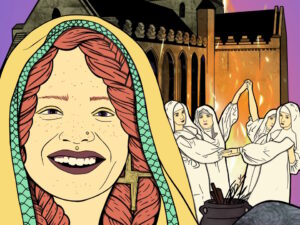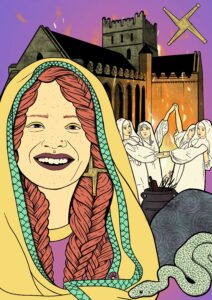
Festival friends will know that, since 2016, we’ve run a strand of work known as In:Visible Women.
Initially responding to #MeToo, and the unveiling of several institutional scandals, our programme has considered individuals, mixed-race families and folkloric goddesses. Along with many others, we started celebrating St Brigid’s Day (1 Feb) a few years ago. Since then, the Irish Government have awarded her a public holiday in Ireland, to be observed nationally from 2023. Each year, we tell stories of Irish women, because so many have been undocumented or remain in the shadow of their male counterparts.
In the third and final trilogy of stories, revealed over 6 months, artist and storyteller Maria Crean unveils the story of Brigid, an Irish female powerhouse and the practices that have followed in her wake.
To see Maria’s first story –Queen Medh– use this link. For Macha, click here. Interested readers may also enjoy Judy Mazonowicz’s The Transformations of Brigid, here.
The first Brigid – a triple goddess
Brigid, meaning ‘exalted one’, was originally the name of the Celtic Fire Goddess representing the flame of knowledge. A triple Goddess, she shared her name with her two sisters, Brigid the Healer and Brigid the Smith, daughters of The Dagda and Danú. As an infant, mythical bees would bring Brigid magical nectar from her orchard in the Otherworld. Wherever she walked, signs of spring -such as daffodils, snowdrops, dandelions, crocus and shamrocks- would spring up.
Sorrow
Brigid’s marriage to Formorian Bres was hoped to end warring factions within her family, the Tuatha Dé Danann. Unfortunately, this didn’t happen and Brigid’s eldest son -Rúadán- was killed in battle. Brigid’s wailing cries, from beside Rúadán’s body, are said to be the first sorrow in Ireland, and began the mourning tradition of ‘keening’, or ‘caointeoireacht’.
Compassion
Brigid’s compassion for her oxen, ram and boar, are one of the reasons she is patron and protector of domesticated and small animals such as badgers, lambs and cows. Many farmers still place Brigid’s triple speared cross in cattle byres (cowsheds) for protection.
Brigid is also the patron of song and poetry, art and crafts; as well as wisdom gained through prophecy and divination. As a fertility goddess she resides over pregnancy, childbirth, midwives and the children of unmarried parents.
Brigid ‘remastered’
In 451AD another Brigid was born in Faughart. Her mother, Broicsech, a victim of slave trafficking, had been sold to Dubhthach, the Pagan chieftain of Leinster. Dubhthach named his daughter after the Celtic fire goddess, unaware of the feisty fire he was lighting in her belly.
Brigid’s charitable nature was evident early on. She gave away her mother’s store of butter, which miraculously replenished itself. She continued to give away her father’s goods, including a gemstone encrusted sword. Tiring of this, her father tried to have her married off to a poet.
Faith and service
Brigid had no desire for marriage and intended to dedicate her life to religious servitude and care for the sick and poor. She begged the heavens to strip her of her beauty so no man would want to marry her. Following harassment from a local man, she reportedly tore out one of her eyes. She cursed the man who had called to her, prophesising ‘soon both your eyes will explode in your head’. Brigid’s beauty apparently returned to her tenfold once she said her vows as a nun.
Brigid began a monastery in Kildare in 468AD, on the site of an ancient oak tree dedicated to her namesake. This tree was so sacred that no weapon was permitted within the vicinity of it. Ireland’s first ‘double abbey’ catered to both male and female devotees. The abbey was famed for its art school, which produced intricate metalworks and angelically illustrated texts, including The Book of Kildare.

Symbols
Brigid’s monastery was the site of an eternally burning flame, cared for by nineteen nuns. Each nun tended the flame for a day, with Brigid tending the flame every twentieth day. This flame was surrounded by a hedge, which no man could cross without finding themselves cursed, insane, crippled or dead. It burned for more than a thousand years after Brigid’s death, until it was extinguished during the Reformation.
Saint Brigid is often depicted holding a square or triangular centred cross made from rushes. She first made this cross at the bedside of a dying Pagan chieftain, while speaking of her faith, converting the man to Christianity on his deathbed. Other miracles performed by Brigid include the restoration of sight, the curing of leprosy and the cursing and blessing of fruit trees. Credited as being Ireland’s first abortionist; Brigid is said to have blessed a woman who had become pregnant unintentionally, causing the child to disappear from her stomach without birth or pain.
Modernity
Brigid shared her bed at the abbey with Darlugdach, described as being her ‘anam cara’ or ‘soul friend’. When Darlugdach felt passion for a young man, Brigid had her walk upon hot coals to save her from spiritual peril. So devoted was Darlugdach that she begged to die alongside Brigid, but instead died one year later, sharing her feast day. Some suggest that Brigid’s relationship with Darlugdach is an early recorded example of female same-sex love.
It is likely that Saint Brigid was the result of ‘syncretizing’, a process amalgamating the qualities and traditions of one culture in to another, in this case, blending the popular Pagan goddess’s traits, stories and influence onto a new Christian ‘Saint’ in order to smooth the process of Christianisation. It is telling that Brigid’s supposed death date perfectly aligns with the Celtic celebration of Imbolg (also known as Imbolc’), when ewes come into life-giving milk and many animals have babes ‘in the belly’. Imbolg was seen as the first sign of hope, for the Celts, of the coming spring after a harsh winter.
Symbols (continued)…
Symbolically, Brigid is represented by her famous cross, but also with lambs, serpents, springs and wells; embroidery objects, water, arrows, beer, bells, corn dolls and cloaks.
Maria has also shared a page from her own Zine, on traditions that have sprung from the celebration of St Brigid. Click here to preview this.
